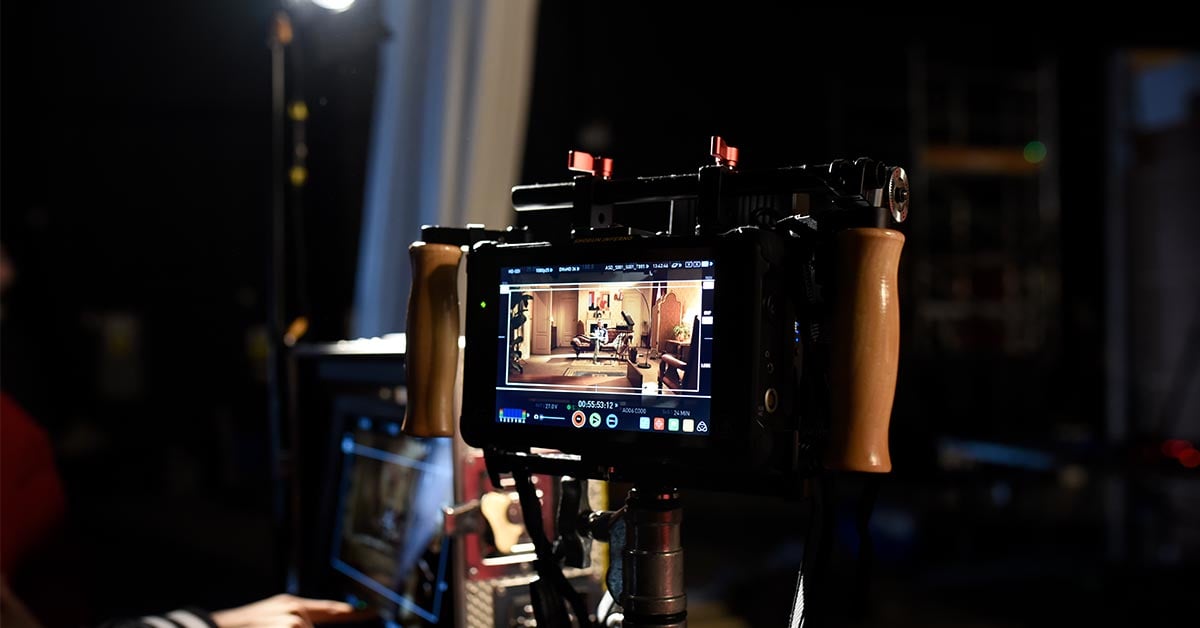
From silent shorts to the box office blockbusters of today, the film industry has continued to evolve since 1905, when Pittsburgh’s Nickelodeon began screening the first motion pictures.
Here, Dr Alex Nevill, Course Leader on our online MA Film Practice degree, shares three emerging trends to watch for within the film industry.
Virtual production
What Alex Says
“Virtual production is a recent approach employed in many film and high-end television productions. This is essentially the use of visual effects or games engine tools to combine CGI (computer-generated imagery) with live-action environments.”
Virtual production is revolutionising the film industry and changing many established production processes. One of its many advantages is its versatility. Gone is the need for expensive sets and locations, instead this cutting-edge technology, including the use of game engines for film production, allows filmmakers to blend the real and digital world, creating live and dynamic backdrops. LED virtual production stages also allow filmmakers to make real-time production changes to the effects and elements, eliminating the expense and delays previously associated with post-production.
Having first begun to experiment with consumer-facing VR equipment while producing Disney’s Jungle Book (2016), Jon Favreau went on direct the CGI adaptation of The Lion King (2019) and is pioneering the use of VR production techniques for episodic TV in Disney+ Star Wars spin-off The Mandalorian (2019-).
Art and production designers, visual effects supervisors and cinematographers collaborated in VR prior to principal photography to decide ahead of time where to put the camera. Massive LED walls displaying dynamic digital sets removed the need for location shoots, while a motion tracking system from Profile Studios and Epic Game’s Unreal engine have allowed real-time, in-camera composition on set.
Shooting on analogue film
What Alex Says
“Shooting on analogue film remains a highly popular choice for filmmakers. In some countries, Kodak have struggled to keep up with the demand for film stock as it’s still being used on blockbuster productions as well as more and more independent films.”
In 2022, a number of major titles shot on analogue film received Oscar recognition, including Don’t Look Up , Licorice Pizza, West Side Story, The Worst Person in the World, Spencer and No Time to Die. Other recent productions shot using analogue film include Kenneth Branagh’s Death on the Nile, Bullet Train and Jurassic World: Dominion.
George Eastman invented the first flexible photographic roll of film in 1885, marketing it commercially in 1889 through the Eastman Kodak company, once one of the world’s largest film and camera manufacturers. The earliest celluloid film, The Roundhay Garden Scene, was shot by Louise Le Prince in Yorkshire, England, in 1888, though the first film completed in Hollywood was The Count of Monte Cristo (1908).
Despite being vulnerable to both light, temperature and moisture changes, analogue film can provide high quality imagery with a distinct visual aesthetic, which is why some directors remain loyal to the format.
For Steven Spielberg and Martin Scorsese, it’s the aesthetic of celluloid that drew them to filmmaking in the first place. Quentin Tarantino sees celluloid “as by far the superior format for cinematic storytelling”, while Branagh feels that “there's a unique quality to the film grain that creates the illusion of a heightened sense of reality”.
Creative documentary filmmaking
What Alex Says
“Creative documentary filmmaking is said to be going through a golden period, though I think this is due to the increase in revenue that some docs are able to generate, rather than a reflection on the quality of films.”
Over the last five years, a number of documentaries have grossed millions at the box office: the Oscar-winning Won’t You Be My Neighbor? (2018) about US children’s television host Fred Rogers ($22.8m); Three Identical Strangers (2018) about triplets separated at birth ($13.3m); They Shall Not Grow Old (2018) about World War I ($12.3m); Apollo 11 (2019) about the space mission ($9m); Roadrunner: A Film About Anthony Bourdain (2021) ($5.4m); and Moonage Daydream (2022) about David Bowie ($4.3m).
Some of the most popular documentary films or TV series (docuseries) aim to inform or educate their audiences by raising important topics and highlighting global social issues. This covers everything from climate change in An Inconvenient Truth (2006) and the fast food industry in Super Size Me (2004), to crime in Conversations with a Killer: The Ted Bundy Tapes (2019) and injustice in Time: The Kalief Browder Story (2017)
The silent film Nanook of the North (1922) is considered by some to be the world’s first documentary, in which filmmaker Robert J Flaherty spent a year following the life of Nanook, an Inuit, with his family in the Arctic Circle. However, the term ‘documentary film’, from the French word ‘documentaire’, was not coined until the mid-1920s by John Grierson, a Scottish film producer, who founded and went on to lead a British documentary-film movement over four decades.
About the Course Leader
Dr Alex Nevill is an experienced cinematographer and filmmaker, whose past work has been supported by Creative England, Channel 4, Film London and screened at major film festivals, such as BFI London, Edinburgh, Palm Springs and IDFA. He now leads Arts University Bournemouth’s (AUB) part-time and online MA Film Practice.
This two-year master’s gives you the opportunity to develop and realise your creative ambitions, exploring new filmmaking approaches which respond to the contemporary world and challenge established mainstream modes of filmmaking:
Related posts
How to become a freelance filmmaker
Turning a hobby into a career or moving from an in-house role? From portfolios to rates, here's all...
Read the storyWhat is sustainable filmmaking?
Learn what sustainable filmmaking is, and the positive impact responsible practices can have on the...
Read the storyOnline MA Film Practice: Student Q&A - Peter Kertesz
Explore the world of online learning with Peter Kertesz, an actor and producer currently studying...
Read the storyStart your creative journey here.
Want to chat or ask a few questions? Fill this in and we’ll give you a call back.
